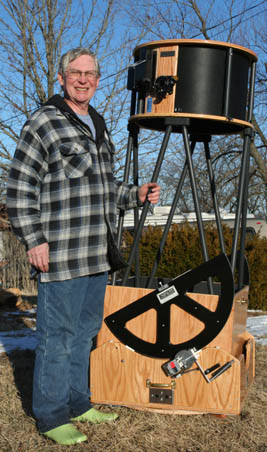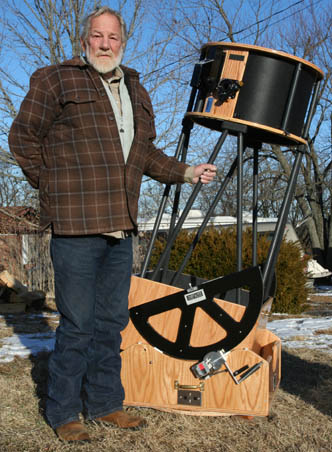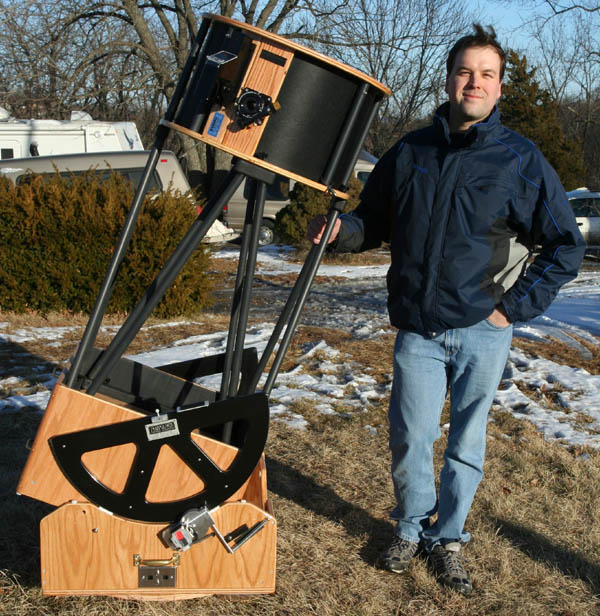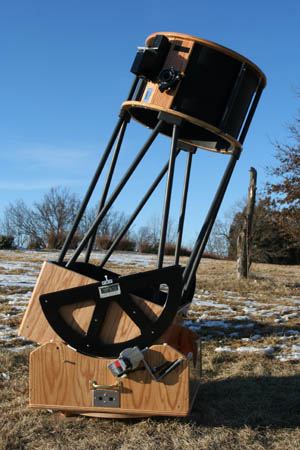
 (Left) Bob Kirschenmann is 5'5" tall, and the eyepiece height is
perfect. Note his stylish green boots! (Right) Rick is taller, and he
can sit on a tall chair and observe any object in the sky, as can I, if
the chair is tall enough.
(Left) Bob Kirschenmann is 5'5" tall, and the eyepiece height is
perfect. Note his stylish green boots! (Right) Rick is taller, and he
can sit on a tall chair and observe any object in the sky, as can I, if
the chair is tall enough.
We headed into
town for dinner. After re-hydrating and re-fueling, we returned to
Bob's under a darkening sky with a not quite first quarter moon and
Venus stacked in the west. However, before we left I got Bob to take a
picture of me with my new telescope. It's so windy that my hair is
blowing all over the place, as you can see. This breeze continued into
the night.
 Me with my new telescope. The wind is blowing (look at my hair) and
the sun is shining in my eyes, but I'm ready for a memorable night of
observing.... after some dinner, of course.
Me with my new telescope. The wind is blowing (look at my hair) and
the sun is shining in my eyes, but I'm ready for a memorable night of
observing.... after some dinner, of course.
The wind was
strong and gusting up to 20-30 mph, and this made the rather warm night
feel fairly cool. The moonlight made it easy to see, and we pulled the
shroud all the way down to keep the interior of the telescope dark.
This makes the telescope more susceptible to being blown around. This
happened a couple times with the drive disengaged but never with the
drive engaged. The worst effect we saw was some shaking of the image
during the strongest gusts.
Pushing the limits - astronomical myth-busting
My first look through the
telescope was at a random part of the sky using a 17mm Ethos. I moved
the scope around and after finding some brighter stars noted no
significant aberrations around the field. If there are/were any, the
seeing was having a larger effect. Stars were round and showed subtle
colors, thanks to the large aperture. The background sky was
surprisingly dark given the moonlight.
It was a bit hard to
believe, but there it was - F/3 WORKS! The myth that fast telescopes
can't perform is completely blown away, and now lies smoking,
smoldering, and twitching in the dirt.... uh... I mean mud.
Ending the disinformation about "thin" mirrors
One manufacturer's
literature claims that a thick mirror guarantees no astigmatism. Many
people take this to mean that thin mirrors can't be made without
astigmatism. Well, as a professional optician who made the 1.25"-thick
20" F/3, and as amateur builder of more than ten telescopes, I maintain
that neither statement is true. A "thin" mirror can be made just as
good as a thicker one by a careful optician, and a "thick" mirror can
be given terrible astigmatism by a careless optician.
The simplest way to
disprove statements of the type that say something can't be done is to
provide a counterexample proving that it can be done - and the 20" F/3
is my counterexample.
No matter where we looked
in the sky, the stars in the field stayed round. The experience was the
same for Rick's previous viewing sessions with the 20" F/3. Yet another
myth busted, lying lifeless beside the road like an unlucky flattened
squirrel. My counterexample just ran it over! I hope the manufacturer
above updates their literature.
Making a mirror thin has
a wonderful positive side effect - the mirrors actually cool off in a
reasonable time. The many lucky owners of 16.5" F/3.7 FX telescopes
already know about the round star images and fast cooling times of
those telescopes.
So, I ask those who own
or have used a 14.5" or 16.5" FX to spread the word around, and help
set the record straight regarding the 1.25"-thick mirrors. Tell your
friends, observing buddies, etc., and post online about how quickly
they cool and how well they perform. I work very hard to make sure
every mirror meets my standards, and I'm going to need your help to get
the truth out there because the myth we have busted with the 14.5",
16.5" and now the 20" F/3 has been perpetuated for quite a number of
years.
Memorable observing with our feet on the (muddy) ground
We aligned on three stars
and then we were off to look at M35, M42, and M78. All looked quite
nice despite the moonlight. Venus was about half illuminated. The moon
was detailed and BRIGHT, and the whole thing fit in the 17mm Ethos with
lots of room to spare. The whole moon was as sharp as the seeing would
allow, with no blurring near the edge of the field. Outstanding.
I stood up
from the observing chair and backed away from the telescope, blind in
one eye from the brightness. I was pleased that I did not have to
descend a ladder to let someone else observe, because that's tricky
when you're moon-blind.
As we were dialing in
other objects, Mr. Kim Colter arrived. As the owner and frequent user
of a couple of larger instruments, he would be our impartial observer,
for a total of four experienced observers.
We again went back to
M42, and the view was very good. M46 was beautiful with the central
star of the imbedded planetary nebula easily visible with direct
vision. Nearby M41 was beautiful, too. Both would look much better at
Chiefland and WSP in a few weeks, I surmised.
The moon was still up,
though, which meant it would improve later on. The Horsehead showed
with an H-Beta filter. We moved up to the California Nebula, and I
assumed we wouldn't see much. However, there it was, taking up a few
fields, some detail and the edge of the nebula clearly visible with the
filter - by far the most enjoyable view I have had of that object to
date.
The 2" O-III filter went
into the 17mm Ethos, and we set off to see Thor's Helmet. It showed
excellent detail with faint extensions revealed. I put a 1.25" O-III in
the 13mm Ethos and liked the view a bit better. The Sculptor galaxy was
too low to see.
By this time we were all blown away by what we were seeing, in a telescope that popular convention said would not work.
So what else could we do? Let's break some more rules! We decided to blast away at another myth.

Exit pupil - who cares?
We broke out some of the
low power eyepieces. I put the 41mm Panoptic in. M42 was nicely framed
- the whole thing. The entire Pleaides fit in the field, as did the
Beehive. In went the O-III filter again, and we slewed to the Rosette
Nebula. There it was, the whole thing in the eyepiece. The secondary
shadow was not visible in the star images, and the view was nice.
Higher power shows more detail in portions of the nebula.
So, the next time you
have the urge to use an eyepiece that yields an exit pupil size greater
than 6 or 7mm, the commonly accepted size "limit", DO IT! Don't listen
to the guy who calculates the exit pupil in his head and tells you
you're foolish to exceed the "limit" of 6 or 7 mm.
While stars will get
dimmer due to light missing your pupil, extended objects (non-stellar
objects) will stay about the same brightness because their light is
concentrated into a smaller area. The result? You get beautiful
wide-field views without dragging another telescope out with you. Try
it, you'll like it!
Beer and the wait for moonset
We took a break to wait
for the moon to set and to enjoy some tea, tasty German beer, and
snacks. We were still amazed at what we were seeing, but we were all
seeing it, and our considerable collective observing skills could not
be wrong. We listened as Kim commented on the quality of the images and
how impressed he was. This was unprompted feedback from a fairly
unbiased observer, and he was impressed. Bob commented on the ease at
which he saw color in M42. I commented that F/3 was not the lowest we
could go with a visual telescope, and I was not sure where the limit
really was. I guess another experimental scope will have to be
built.....
It gets better
We emerged into a darker
outside world, with the now-dim moon lying on the horizon. The
Orion-Canis Major region was noticeably more populated with faint
stars, and the winter Milky Way had popped out. It was still windy, and
the seeing was still poor, but M42 looked better than I can remember it
anywhere. For quite some time I studied the many levels of light and
dark nebulosity in M42 and M43. The others followed. The Horsehead was
even more evident with and H-beta filter, and M46 was quite beautiful.
Thor's Helmet was examined again with slightly higher power. Nebulosity
was evident in the Pleaides with the 41mm Panoptic.
The double cluster was
quite beautiful in any eyepiece. The color in the various stars was
evident and striking. Cruising around and down into Cassiopia I
stumbled across the ET cluster, which I couldn't recall observing for a
while.
We turned to M51. At this
point some high haze was drifting in, and there was some light
pollution in this part of the sky. The view was OK. M81 & M82 fit
in one field, as did M65, M66, and a companion NGC.
At this point, with high haze moving in, we decided to pack up.
Conclusion
For some reason there
were lots of cars driving by Bob's house that night, so we were never
truly dark adapted. That made the observations, particularly those of
low-contrast objects, just that much more impressive. Getting this
telescope under a dark sky is going to be a fantastic experience, and I
hope that happens soon.
In summary, we busted four major astronomical myths. Here is what we have seen to be TRUE:
- 1) A 20"x1.25" mirror is
NOT too thin - it works well, cools fast, and is much easier on your
back! We did not see any astigmatism.
- 2) F/3 is NOT too fast for visual use - with a Paracorr and Ethos
eyepieces, it give superb images! I am not sure where the limit lies.
- 3) You CAN exceed the size of your eye's pupil and get enjoyable images!
- 4) You CAN have fun observing in strong breezes - a 20" F/3 is compact and wind resistant!
This experience has left
me wondering where the lower limit for visual observing is. For a
commercial telescope, F/3 requires careful collimation adjustments and
some practice, but it is quite doable for the motivated observer. Any
faster, though, is uncharted territory.
So, pending some more
observing with it in Florida, I think I'm comfortable offering the 20"
F/3 MX as a product. It won't be cheap, given the work required to make
a good F/3 primary, but it will be unlike anything available on the
market. That's my kind of product.
If you are interested in a 20" F/3 or 22" F/3.3, give Rick a call. That will let us know there is interest.
- Mike Lockwood, Lockwood Custom Optics

|



